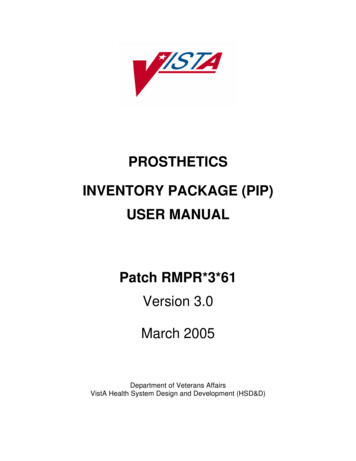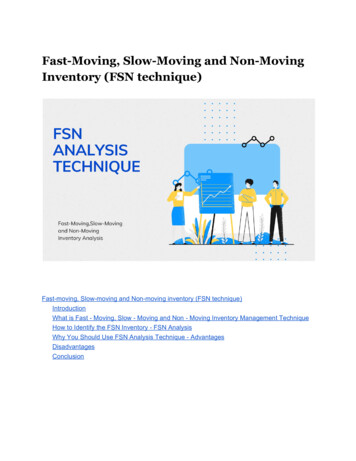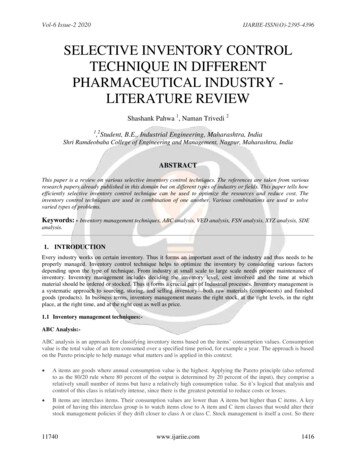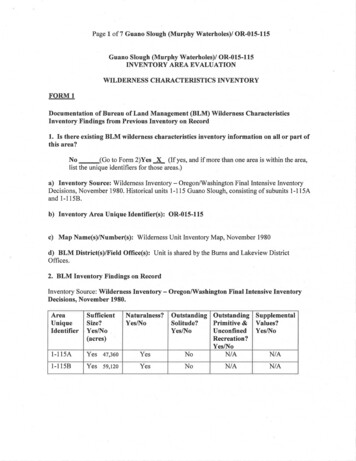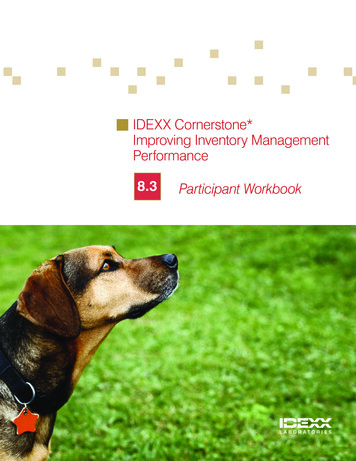
Transcription
School of Innovation, Design and EngineeringInventory Management: Acase study at VolvoConstruction EquipmentMaster thesis work30 credits, Advanced levelProduct and process developmentProduction and LogisticsParth JwalaReport Code: PPU 503Commissioned by:Tutor (company): Sean CarterTutor (university): Yuji YamamotoExaminer: Antti Salonen1
ABSTRACT IntroductionIn today’s world, manufacturing companies are keen to adopt lean methodologies to sustainan everchanging market. One way companies grow their business is by increasing customersatisfaction, customization and running the business in the optimal scenario. Inventories forma significant amount in applicable businesses, estimating around 30%, a number that has thepotential to be decreased that would turn direct profits. The following two research questionswere therefore answered.Q1. What are the potential factors which affect the inventory size in the leanproduction facility?Q2. What should be the inventory management approach in a lean manufacturingenvironment? MethodologyThe literature review was performed to get an understanding of the current study on thistopic. Further a site was visited, and the case study approach was adopted. While gatheringdata, semi-structured interviews were conducted with engineering, line management andoperations. Observation technique was also used to collect empirical data. Theoretical frameworkTheoretical study based on literature review helps authors to understand the complete systemdeeply from a lean perspective as manufacturing takes place in the lean environment. Thetheoretical framework helps in finding the right approach to the problem and showcases thepotentially problematic areas to be focused on. Empirical dataEmpirical data shows the actual image of the problem in the case company. It also shows thepossible factors that are responsible for the present condition. These factors are representedwith the help of the fishbone diagram. Analysis and resultsQuantitative analysis was done based on data collected. Two approaches were proposed inwhich approach 2 answers the problem for sufficient buffer size. Cross-check analysis wasalso performed on the actual production plan from week 10 and 11 this cross-check analysisstrengths the reliability of the research work.
Conclusions and recommendationsThe conclusion is drawn based on the analysis performed with the foundation of datacollected. Although significant challenges are answered with the help of research questions,human involvement and absence of monitoring policy limit the reliability of the proposedresults. The future recommendation is to perform the proposed solution on simulation andcheck the validity of different scenarios.(Keywords: buffer management, lean inventory, inventory management, the theory ofconstraints, continuous improvement)3
ACKNOWLEDGEMENTSAcknowledgements for this research project go to: Volvo CE Hallsberg, SwedenSean CarterPer-MartinMagnus TångringDonny KarlssonJonas AnderssonJanos JohanssonChristian NilssonStephen Francis Mälardalen University Leaders for production development and logistics programAntti SalonenYuji YamamotoTO MY PARENTS WHO ALWAYS MOTIVATE ME
CONTENTS1.INTRODUCTION . 81.1.1.2.1.3.1.4.2.RESEARCH METHOD . 122.1.2.2.2.3.2.4.2.5.2.6.2.7.3.DEFINITION OF LEAN MANUFACTURING . 18LEAN INVENTORY . 19TOYOTA PRODUCTION SYSTEM . 20VOLVO PRODUCTION SYSTEM . 22JUST-IN-TIME . 25CONTINUOUS IMPROVEMENT AND ICEBERG CHALLENGE . 26ROOT CAUSE ANALYSIS . 29INVENTORY & THEORY OF CONSTRAINTS . 30EMPIRICAL DATA . 324.1.4.2.4.3.4.4.4.5.4.6.5.RESEARCH PROCESS . 12CASE STUDY . 13LITERATURE STUDY . 14DATA COLLECTION . 15DATA ANALYSIS . 15QUANTITATIVE AND QUALITATIVE METHODS . 16VALIDITY AND RELIABILITY . 16THEORETIC FRAMEWORK . 183.1.3.2.3.3.3.4.3.5.3.6.3.7.3.8.4.BACKGROUND . 8PROBLEM FORMULATION. 9AIM AND RESEARCH QUESTIONS . 10PROJECT SCOPE AND LIMITATIONS . 10ABOUT CASE COMPANY . 32CASE DESCRIPTION . 33PROCESS DESCRIPTION . 33ROOT CAUSE ANALYSIS OF THE PROBLEM . 35APPROACH FOR LEAN INVENTORY . 39EVALUATING THE APPROACH FOR LEAN INVENTORY . 43ANALYSIS & RESULTS . 455.1.5.2.RESEARCH QUESTION 1 . 45RESEARCH QUESTION 2 . 456.DISCUSSION . 487.CONCLUSION & FUTURE RECOMMENDATIONS . 498.REFERENCE . 509.APPENDICES . 605
ABBREVIATIONSVolvo CEVolvo Construction EquipmentTOCTheory of ConstraintsJITJust in Time
LIST OF FIGURESFigure 1 Illustration of the research process (Yin, 2014; Jenkins, 1985) . 12Figure 2 The Toyota production system (Liker, 2004) . 21Figure 3 Volvo Production System pyramid (Volvo Group, 2008). 24Figure 4 Kai & Zen logogram (Medinilla, 2014) . 27Figure 5 Continues Improvement Iceberg (Hines, et al., 2008). 28Figure 6 Final Products at Volvo CE Hallsberg, Sweden . 32Figure 7 Current inventory scenario with 46 products at VCE Hallsberg, Sweden . 34Figure 8 Ishikawa (Fish bone) diagram for Volvo CE, Hallsberg, Sweden . 35Figure 9 Process chart at Volvo CE Hallsberg, Sweden . 38Figure 10 Graphical representation of inventory stock in ideal condition. 42Figure 11 Graphical representation of inventory stock in actual condition . 44Figure 12 Future inventory scenario with 34 products at VCE Hallsberg, Sweden . 477
1. INTRODUCTIONThis chapter provides the general background of the main issues on which this master’s thesisis performed. The main research question, as well as the project’s goals and limitations, areexplained further in this section.1.1. BackgroundLean manufacturing is one of the practices that many manufacturing firms are adopting toremain competitive in the global market (Abdulmalek & Rajgopal, 2007). The main focus ofthe lean approach is to eliminate non-value-added activities. This helps in saving time,lowering associated cost and in achieving a higher level of customer satisfaction (Liu, et al.,2007). The concept of lean originated from Toyota Production System. The concept hadmany tools and techniques, for instance, Just in time (JIT), total productive maintenance(TPM), single minute exchange of dies (SMED), and more. Today, these tools and techniquesare widely used in the manufacturing environment.The philosophy of lean production considers inventory as a form of waste that must bereduced. In recent years as companies adopted lean manufacturing system, management ofinventory in this system became lean inventory management (Eroglu & Hofer, 2011).According to Kuhlang, et al., (2011) and Glock, (2012), inventory is associated with leadtime, as it involves transport operations which result in higher idle time. Having long idletime results in loss of associated capital and in short, loss of business. The reason why manymanufacturing companies adopt the lean manufacturing system is because it improves theirbusiness through for instance high productivity, reduced lead time, improved quality,reduction in space, reduce inventory and more (Ghosh, 2013).In lean manufacturing, there are seven types of identical wastes mentioned, i.e.overproduction, unnecessary motion, inventory, transportation, rework, waiting, and over theprocess. Although each waste has its business impact, inventory is one of the least discussedwastes, a reality that needs to be addressed as it has maximum capital and resourcesassociated with it (Upadhye, et al., 2010; Ghosh, 2013). According to Kuhlang, et al., (2011)more inventories cause higher lead time because of transport, operating times and idle time.Associated non-value costs are hence added and counted as potential causes for bottom linelosses. While inventories are directly associated with performance, lean inventories increasethe organization’s performance and also improve operational outcomes (Eroglu & Hofer,2011). There are mainly two views present in previous studies on literature related toinventory, i.e. romantic JIT and pragmatic JIT. Romantic JIT suggests that there should notbe any inventory which is in ideal condition. Whereas pragmatic JIT suggests that thereshould be an optimal level of inventory present in the factory and this optimal level isdependent upon its associated cost, operational processes and production plan (Eroglu &Hofer, 2011; Chen, et al., 2005; Chen, et al., 2007).
For many years manufacturing companies, whether having small scale or large-scaleoperations, have been searching ways to be a leader in their respective segment.Organizations are improving their business and competitiveness by understanding theirinventory levels and implementing processes to reduce these levels. By reducing inventory,companies experience benefits to the bottom line, and less inventory means fewer resourcesassociated with it. The resources saved by lowering inventory up to its optimal level can beused in different improvements initiatives (Brooks & Wilson, 1995). The AmericanProduction and Inventory Control Society (APICS) defines inventory management as the partof business management associated with planning and controlling of materials in the form ofinventory (Toomey, 2000). Management of inventory is an essential part of supply chainmanagement (SCM). Over the last three decades, much research has been done on SCM, andits integration with inventory management called multi-echelon inventory theory (Quayle &Quayle, 2000). A survey of inventory management cost in Europe identified the cost ofinventory management in the manufacturing setting which is equal to 28% of the totalproduction cost (European Logistics Association (ELA) & A.T. Kearney ManagementConsultants, 2004).Many large companies are engaged with inventory management to save cost and improveefficiency (Chapman, et al., 2000). Different businesses, small scale to larger ones, havevaried resources at their disposal. Smaller ones have a different approach to management ofgoods on their shelves while the larger ones approach their inventory differently. Because ofthis difference in resources, and the subsequent varied approach to inventory management,the traditional view that smaller scale organizations look up to the larger ones is debatable(Welsh & White, 1981). Inventory management is very crucial as it plays a vital role inproviding products (raw, semi-finished, etc.) at all levels required. Inventory is associatedwith many costs which generally includes purchasing cost, processing cost and other costs.Therefore, companies should practice achieving the optimal level of inventories from thebusiness perspective (Vollmann, et al., 1992).Balancing the flow of material according to demand is a critical factor to success. Inventorybuffer should be designed in a way that it can sustain demand even if demand is flexible.Whereas holding much more inventory might cause loss in cost and resources. Hence, havingsufficient inventory is the ultimate goal (Coyle, et al., 2003)1.2. Problem formulationIn today’s global environment, companies follow the trend of lean manufacturing to sustainin the ever-changing market. This trend majorly involves management of resources and oftenis known as lean management; one of the majors of this management is on reducinginventory (Aqlan & Lam, 2015). Inventory management is that area in production planningand manufacturing research which applies wise mathematical models. These techniques aim9
to find a solution to the problem, by using a variety of elegant mathematical techniques suchas complete enumeration (Zinovy, 1998), branch and bound (Lu, et al., 1989) and theory ofconstraints (Hurley, 1996). Having more than required inventory is always a challenge whichaffects the business development in the companies, whereas having lower inventory increasesthe risk of having material shortage or production stop (Aqlan, et al., 2015). So, it issuggested to have an optimal size of inventory according to the company productionrequirement (Pakdil & Leonard, 2014).Manufacturing companies are facing problems in managing their inventories and buffer sizes.Companies are doing their best to optimize this buffer size and achieve their lean goals whichfurther help the companies to strengthen their business in the competitive market (Prasad, etal., 2016; Panwar, et al., 2018; Kroes & Manikas, 2018).1.3. Aim and Research questionsThis thesis project aimed to investigate and identify the potential factors which affect theinventory size in the lean manufacturing environment and how the optimal inventory size canbe achieved. This research study was conducted at Volvo CE cab manufacturing factory inHallsberg, Sweden. The chief assigned study area in the factory was the inventory buffer(Buffer out) between the paint department and assembly department.Two research questions were formulated to achieve the aim of the study.Q1. What are the potential factors which affect the inventory size in the lean productionfacility?Q2. What should be the inventory management approach in a lean manufacturingenvironment?1.4. Project Scope and limitationsThe research project was focused on the automobile sector, where the active stakeholdersfrom the company side are process engineers, line operators and lower-level managers.Limitation of the resources limits the study from a different perspective. The research studywas focused on internal inventory management of Volvo CE, Hallsberg factory. Theinteraction with other departments in the factory is excluded and limited to only paint andassembly.
The suggested approach for inventory management is based on the data analysis performedon the data collected only from the case company, i.e. Volvo CE at Hallsberg, Sweden. Thatmeans the typical proposed buffer size might not satisfy the other case but can be calculatedby the approach used. Moreover, the reliability of data used can be questioned as the datamonitoring policy includes involvement from humans. However, these must not lead one toquestion the authenticity of the data. Further, there are certain limitations in the factory.These are that the factory works on the pull system, which means that the flow of materialfrom the paint department is based on demand from the assembly department. In addition,there are certain human centered breaks during the day in the assembly shop when workcomes to a standstill. One break is for lunch while the other is for coffee. The paint shop hasno such breaks. For the purpose of this study, both these breaks in the assembly shop havebeen merged and assumed to be one break. There is no documented data for these breaks.11
2. RESEARCH METHODIn this chapter, a description of the research method used for this research study has beenpresented.2.1. Research processManagement-related research usually showcases new findings. Along with that these studiesalso address management issues, business-related issues and practical problems (Saunders, etal., 2003). The process for research generally includes topic formulation, theoreticalframework, data collection, empirical findings, analysis and conclusion. This process is notjust one-time. Researchers break down the process into stages from time to time to meet theright ideas (Jenkins, 1985). This research study follows the vision of investigating the optimalinventory size and how it can be achieved with a scientific approach at lean manufacturingcompanies. According to existing literature, the research process consists of a loop withmultiple stages that addresses the entire research project, and these stages relativelystrengthen the overall research study in terms of reliability (Jenkins, 1985).Figure 1 Illustration of the research process (Yin, 2014; Jenkins, 1985)
This loop having multiple stages is further explained in diagrammatic form; these stages arefollowed thoroughly to the research. The reason for using this structured loop is that it helpsthe author to maintain a high level of authenticity of the data from different levels in thefactory. Moreover, this feedback cycle strengthens the case study approach, especially whenthe majority of data collection is done from the monitoring processes where humaninvolvement is high.Illustrated project plan in Figure 1 considers five different stages which were acted as thefoundation of this research project. A feedback loop was active throughout the project so thatany new information during the project can be handled carefully and into the right slot in theproject. This parallel feedback loop is essential for this project because the overall projectplan is divided among different stages. With the high possibility of getting new informationor data on different stages, this loop helps in connecting that information from differentstages. These stages can be further described below.2.2. Case studyA case study is defined as the systematic approach to perform research which includesempirical data analysis investigation of a particular system with actual existence in contextwith academic theories (Saunders, et al., 2003). The case study includes gathering data viadifferent approaches from different sources by doing workshops, interviews, constantobservations and adding stakeholders to the process of data collection this helps in buildingreliable conclusions and bridge the gap between literature and empirical studies. The casestudy research must be performed on multiple pieces of evidence (Gillham, 2000). This casestudy is further explained as a single case study as it involves only one case company.Employing this approach enables the author to deeply understand the context and help instaying focused on specific management issues (Yin, 2009).This case study approach is an excellent blend of three different approaches within the casestudy, i.e. an exploratory, explanatory and descriptive study. These can be defined as follow.Exploratory:This approach is used when much of the current situation is unknown from academiaperspective, or there is the unavailability of the solution to similar problems in the past(Saunders, et al., 2003). These kinds of studies are conducted by using extensive literaturestudy, constant communication with experts, conducting interviews (Sekaran, 2003). Theauthor has used partial use of this approach during the interview’s sessions, the reason behindthe usage of this approach in the study presented is that it provides the freedom to the authorto control the flow of information during the interviews (Prince & Felder, 2006).13
Descriptive:This approach is used to explain the set of variables in certain situations (Sekaran, 2003).Therefore, this approach is used to provide a platform to the researcher’s perspective in anindustry-oriented research. This approach is used in this research mainly to strengthen theauthor’s hypothesis in the analysis and the reason behind it is the versatility of the descriptiveapproach. This approach helps the author to frame the reliability of the proposed results basedon facts interpreted and generated (Barrows & Tamblyn, 1980).Explanatory:A study which connects the different theories with a single string of idea can be named asexplanatory study (Saunders, et al., 2003). Furthermore, the explanatory study is dividedbetween casual study and correlation study. The casual study is one where the problemoccurs due to one variable, whereas correlation study is one where the problem occurs due tochain reaction in variables (Sekaran, 2003). The correlation study approach is used in onepart of the empirical study, where the cause and effect study is explained. The objective ofusing this approach is to increase the understanding of the research study as it does notprovide final, conclusive results but instead give a clear overview about the problem and itspotential causes (Barrows & Tamblyn, 1980).2.3. Literature studyThe primary goal of the literature study is to demonstrate the theoretical framework of thisthesis project and get an overview of the current studies on the research topic from theauthors perspective (Yin, 2009). Different databases were used to dig into the literature studyand present the concrete theoretical foundation for the thesis. The main databases used areScopus, Science Direct and Google Scholar. Moreover, the keywords used to search theliterature on these databases were inventory management, buffer storage management,continues improvement and lean inventory management. During the search for literature onthe mention databases, some filters were used such as the language must be in English,content should be relevant to the manufacturing engineering field and priority should be tothe case study research, which helps in understanding the issue very deeply. Anotherobjective of this stage is helping to build an interactive bridge between the researchers andthe business companies. However, this phase includes the in-depth study of literature fromdifferent sources, but it is a continuous process that goes on throughout the project wheneverany information is added. Also, the visiting the company helped in understanding theproblem from the on-ground perspective. The reason for this initial visit at the case companywas that it helped the author to balance the problem from two different perspectives, i.e.academic or literature perspective and company perspective (Jenkins, 1985). The totalnumber of visits to the case company was 12 for the total duration of the project.
2.4. Data collectionCollection of facts or information from different resources in form of number, alphabetsimage graphs, and more is called data collection. Valuable data must be reliable, authentic,simple to understand and accurate (Yin, 2009). Data collected in this research project is fromdifferent resources and is majorly collected by visiting case company through interviews,brainstorming sessions with mentors and stakeholders, meetings, observations and weeklyreports.The approach of interviews was used in a semi-structured way. The reason to use semistructured interviews was to help the interviewer to continue the interview by askingquestions based on answers given by participating persons (Jenkins, 1985). The questionsasked during the interview were mainly framed in such a way that the interviewer got anopportunity to understand the viewpoint of the interviewee. Majority of people whoparticipated in the interviews were line managers, process engineers and operators as thesepeople are mainly involved in the process, so it is assumed that their viewpoint is crucial tounderstand. For the collection of data inside the factory, the MSA (measurement systemanalysis) approach is used. The reason behind using this approach is to ensure data validity(Dahlgaard & Dahlgaard-Park, 2006; Kumar, et al., 2006) as this approach includesoperational processes associated with processing of different departments. Initialbrainstorming sessions were conducted with operators and line engineers, which provided anoverview of the process along with the deep insight of the possible potential causes. Data wascollected with the help of project managers, which was then verified and based on the resultsof brainstorming sessions. Data study process chart was produced with top to bottom flow,which showed movement of product from start point to endpoint through differentdepartments.Other than that, the observational data collection process was also used in this study. Thisdata collection process consisted of guided tours with engineers of the manufacturing facility.Attending the morning round table meetings for production planning helped in understandingthe working culture of the company. All the data collected in this way comes under theprocess of observational data collection (Yin, 2014). Data collected from the above process isof great use in this report. Sources for the data were authentic and reliable, which helps inconcluding a highly reliable result. Data from the literature helps in getting a deepunderstanding of the problem from the research perspective instead of a business perspective.Previously conducted researches for the same problem gives an insight into the real problem.2.5. Data analysisThe data analysis process was started with organizing the data collected from internalstakeholders in the form of interviews, observational meetings and visits. The data was15
arranged according to the date of the collection. After organizing the data, analysis wasperformed to see the standard information in all the interviews. These similarities were foundbased on some keywords. The reason behind finding the conventional strings among all theinterviews helped in understanding the collective viewpoint of the internal stakeholder (Yin,2014). Here the feedback loop acted as a reliable source. While analyzing the data someinterpretations were made by the author which were discussed with stakeholder via afeedback loop. Data was used as part of this study only after receiving confirmation from theauthorized representative of the company. After doing this analysis, some concrete facts weredrawn which was further balanced with literature study with a focus on the research questionsso that main essence of research must not be diluted (Miles, et al., 2014). On gettingconfirmation of this evidence with stakeholders through a feedback loop, a hypothesis wascreated. In further analysis, a conclusion was drawn (Saunders, et al., 2003).2.6. Quantitative and qualitative methodsQuantitative research, also known as numeric modelling, is used to model numeric data sothat it is easy to understand the process. This modelling results in equations, graphs, tables,and charts. One limitation of th
inventory (Toomey, 2000). Management of inventory is an essential part of supply chain management (SCM). Over the last three decades, much research has been done on SCM, and its integration with inventory management called multi-echelon inventory theory (Quayle & Quayle, 2000). A survey of inventory management cost in Europe identified the .



